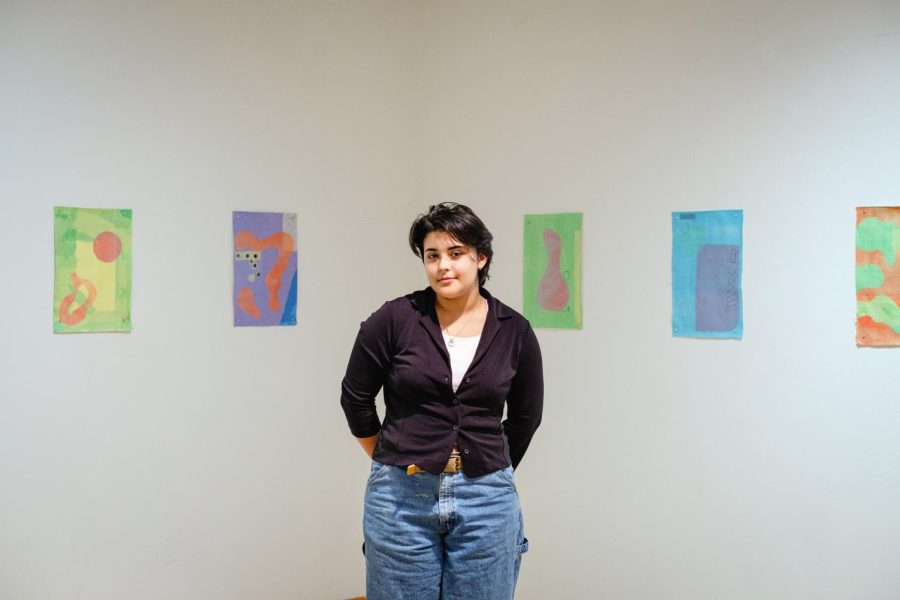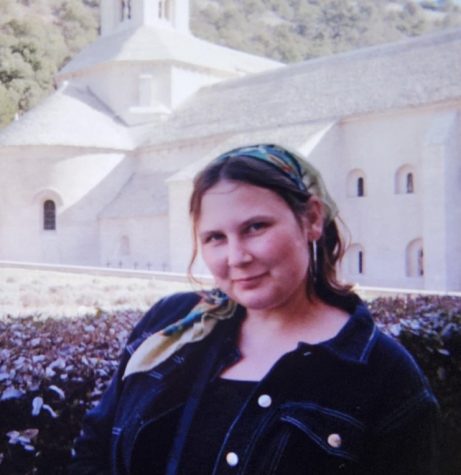A small show with a big heart: “Xoti” in Smith Gallery
Bhuyan’s exhibit is composed of five prints made using the printmaking technique chine collé.
November 10, 2022
The print’s reddish-orange tissue paper, dried in ridges, eerily resem- bled veins and capillaries, according to Jillian Bhuyan’s `24 friends; “It looks like skin,” Bhuyan admitted.
Jillian Bhuyan displayed their exhibit “Xoti” in Smith Gallery with five prints, all of which they created specifically for the exhibit. Bhuyan used the printmaking style “chine collé,” which involves layering tissue paper of different colors and designs using an adhesive, often wheatpaste. Bhuyan also used rectangular reverse stamps with relief ink on several of the pieces. The range of bright colors and use of organic shapes in each of the prints naturally links the pieces in the collection.
The exhibit’s name is the word for “small” in Assamese, the language of the northeast Indian state of Assam, where Bhuyan’s family is from. Bhu- yan chose the name due to the limited number of pieces in the exhibit and because they liked the way it sounded, but said naming their art is not some- thing they’re fully comfortable with yet. “I don’t think it ever feels not corny,” they said. Visitors to the gal- lery may notice that none of the five prints are named.
The prints explore abstraction, an artistic field relatively new to Bhuyan, who had been most interested in still lifes and portraiture when they first started taking classes at Grinnell Col- lege. It was a printmaking class at the College that first introduced Bhuyan to abstraction, and they have been in- trigued ever since.
Bhuyan’s prints include shapes ranging from the organic to the sci- entific. While more familiar shapes like circles and rectangles make ap- pearances, it is the abstract shapes that draw the viewer in.
Visitors with a particularly keen eye may observe that certain shapes are repeated across several of the prints, including the orangish positives cut from one sheet of tissue paper used in the skin-like print and repurposed in another piece with more purple tones. This in-the-moment transplanting al- lowed Bhuyan to conserve materials while also creating a design tether be- tween the prints.
Studio art majors are required to participate in BAX, the end-of-year Bachelor of Arts Exhibition, before they graduate, but shows in Smith Gallery, located just outside the Din- ing Hall in the Joe Rosenfield Center (JRC), are recommended as another opportunity to showcase a cohesive body of work. Bhuyan said they think the Smith show is great practice in ex- hibiting and had been looking forward to staging their own since declaring the major.
“It’s really vulnerable to share your work,” Bhuyan said, but they also gained a new perspective on their own art by exhibiting it. By displaying their own art in a space free of other distractions, they said they were able to see it in a way they never had be- fore.
Bhuyan did not have a traditional opening for their Smith show, instead opting to show their exhibit for the first time to a smaller gathering of friends. While showing their art to others in- volved stepping out of their comfort zone, Bhuyan said it also provided feedback to inform how they should approach their own work in the future. “Knowing what people respond to and also being able to open my mind to other people’s experiences gives me more tools to be able to shape the experiences and reactions that I want,” Bhuyan said. “Or maybe what things to avoid.”
Bhuyan said they hope those who visit the exhibit take the time to ob- serve the prints and explore the many layers they might find. “I like when people get all up close,” they said.
“Xoti” was set to close on Oct. 7, but due to a gap in the Smith Gallery schedule, it might be possible to catch the exhibit for a longer period before it is removed from the space.



















































